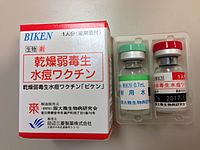
Photo from wikipedia
National one-dose varicella vaccination at 12 months of age was implemented in Taiwan since 2004.Our study aimed to evaluate breakthrough varicella (BV) in post-vaccine era and its associated risk factors.… Click to show full abstract
National one-dose varicella vaccination at 12 months of age was implemented in Taiwan since 2004.Our study aimed to evaluate breakthrough varicella (BV) in post-vaccine era and its associated risk factors. We retrospectively identified children vaccinated against varicella between 12–23 months of age during 2004–2008. Their vaccination information was extracted from the national vaccination registry system and linked to the 2004–2014 National Health Insurance database. BV was defined as a diagnosis of varicella (ICD-9-CM codes 052 and 052.0–052.9) beyond 42 days post-vaccination. Multiple Cox regression model was used to identify risk factors for BV. Among 932,874 enrolled vaccinees, 26,446 (2.8%) had BV and 219 (0.024%) required hospitalization over the study period. Varicella incidence declined from 4.71 per 1000 person-year (PY) in 2004 to 0.81/1000 PY in 2014. BV incidence decreased from 3.90/1000 PY at first year to 1.94/1000 PY at 11th year after vaccination. Females had a lower risk for BV than males (hazard ratio [HR] 0.85, 95% CI, 0.83–0.87); Varivax® recipients had a lower risk for BV than Varilrix® recipients (HR 0.75, 95% CI, 0.72–0.78). Our study showed the incidence of varicella, BV and varicella-related hospitalizations in Taiwan were kept low in post-vaccine era.
Journal Title: Scientific Reports
Year Published: 2018
Link to full text (if available)
Share on Social Media: Sign Up to like & get
recommendations!